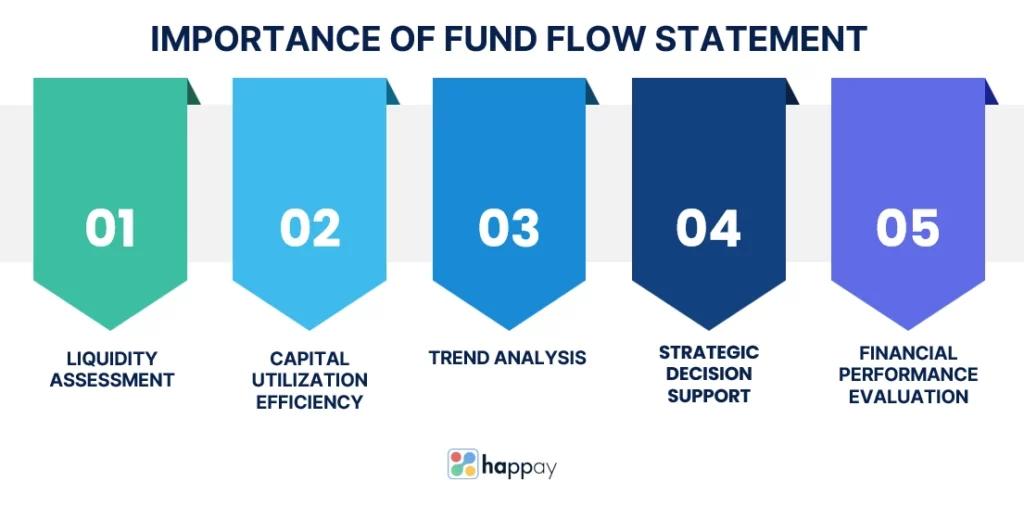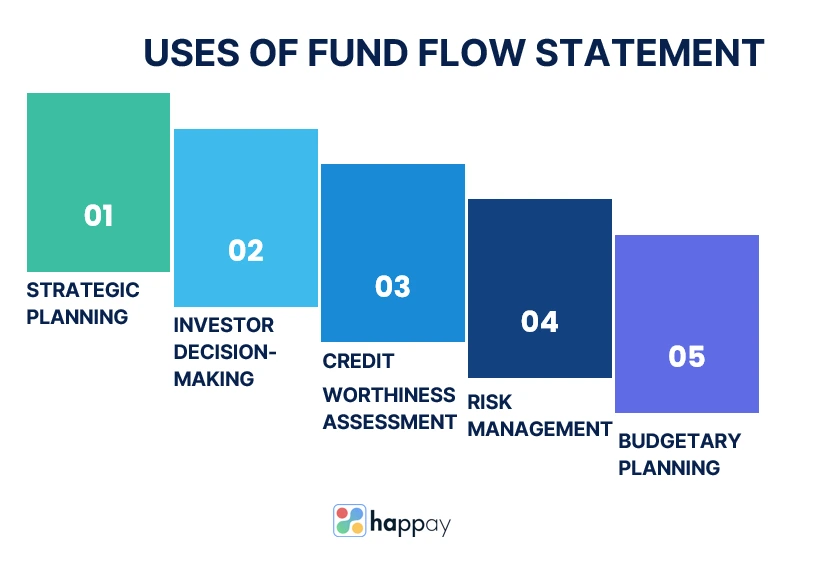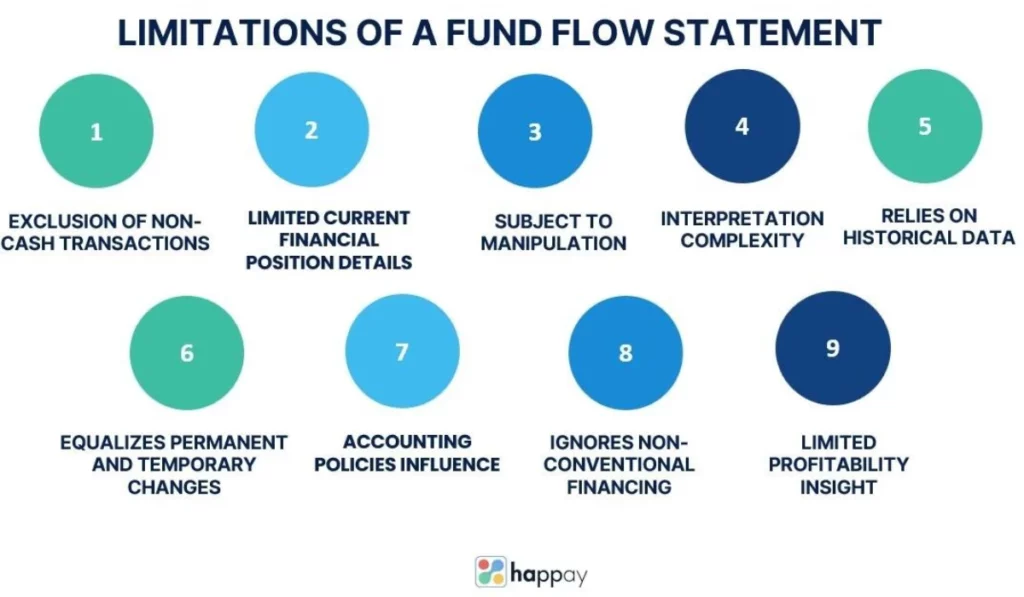Introduction
The fund flow statement is a vital financial document in corporate accounting. It offers a comprehensive overview of a company’s financial activities over a specific period. Furthermore, it is a dynamic tool for assessing a company’s liquidity and financial health. The statement also facilitates the identification of the sources and applications of funds to show how capital moves within an organization.
Understanding the finer aspects of this statement is thus crucial for investors and financial analysts. This article looks at the various aspects of the fund flow statement to help you understand its role in enhancing the financial decision-making process.
Read More: Cash Flow: What is it, Types, How does it works, Formula & Example
What is a fund flow statement?
A fund flow statement is a financial document that systematically presents the inflow and outflow of funds within an organization over a specified period. Also known as a statement of changes in a company’s financial position, it provides a detailed account of how funds move through various activities. More importantly, it highlights the sources and applications of capital.
This statement includes changes in net working capital, investments, and financing activities to offer stakeholders a comprehensive understanding of a company’s working capital and financial dynamics. Analyzing the statement allows investors and analysts to gain insights into the organization’s liquidity and operational efficiency.
Importance of fund flow statement
Here are five reasons why a fund flow statement holds immense importance.

1. Liquidity assessment
Outlining the sources and uses of funds helps the statement provide insights into the organization’s ability to meet short-term financial obligations and operational needs.
2. Capital utilization efficiency
This financial document offers a detailed breakdown of fund allocation across various activities, including investments and working capital. The analysis is instrumental in optimizing resource allocation and enhancing financial performance.
3. Trend analysis
The statement facilitates trend analysis by presenting a historical perspective of fund movement over different periods. Stakeholders can identify patterns and trends to predict future financial activities.
4. Strategic decision support
As a comprehensive financial document, it provides management and investors with a clear understanding of the economic drivers shaping the organization’s growth.
5. Financial performance evaluation
The analysis provided by the statement goes beyond traditional profit and loss considerations. It offers a better understanding of the financial dynamics that impact an organization’s bottom line.
Uses of fund flow statement
Here are some significant uses and advantages of a fund flow statement.

1. Strategic planning
The statement offers valuable insights into the allocation of funds across different activities. The information assists management in aligning financial strategies with organizational goals.
2. Investor decision-making
Investors rely on the statement to decide about a company’s financial stability and growth potential. Understanding the movement of funds allows investors to check the organization’s ability to generate returns and meet obligations.
3. Creditworthiness assessment
Scrutinizing the sources and uses of funds helps creditors gauge the company’s ability to meet its financial obligations.
4. Risk management
The statement helps identify potential financial risks and mitigate strategies. It allows organizations to navigate challenges and uncertainties better.
5. Budgetary planning
Organizations use the fund flow statement for budgetary and financial planning, as it offers a granular account of expected cash outflows and inflows.
Quick Read: 10 Best Financial Management Tools
Fund flow statement format
Sources of Funds |
Uses of Funds |
|
I. Net Increase in Working Capital |
|
|
1. Increase in Current Assets |
[List of specific items] |
|
2. Decrease in Current Liabilities |
[List of specific items] |
|
II. Long-term Sources |
|
|
1. Issuance of Equity Shares |
|
|
2. Long-term Borrowings |
|
|
III. Additional Income |
|
|
1. Non-operating Income |
|
|
2. Sale of Investments |
|
|
3. Other Inflows |
|
|
Total Sources of Funds |
[Sum of all sources] |
|
IV. Net Decrease in Working Capital |
|
|
1. Decrease in Current Assets |
[List of specific items] |
|
2. Increase in Current Liabilities |
[List of specific items] |
|
V. Long-term Uses |
|
|
1. Repayment of Long-term Borrowings |
|
|
2. Purchase of Fixed Assets |
|
|
3. Investments in Marketable Securities |
|
|
VI. Operating Expenses |
[List of specific expenses] |
|
VII. Dividend Payments |
|
|
Total Uses of Funds |
|
|
VIII. Net Change in Funds |
[Total Sources – Total Uses] |
|
IX. Opening Balance of Funds |
[Opening balance amount] |
|
X. Closing Balance of Funds |
[Opening balance + Net Change] |
How to prepare a fund flow statement?
Here are the steps in creating a fund flow statement.
STEP 1: Collect financial data
Gather comprehensive financial information, including balance sheets and net income statements for the given period of time. Ensure the data is accurate and reconciled.
STEP 2: Identify changes in working capital
Note any increases or decreases in cash, accounts receivable, accounts payable, and inventory, as these directly impact the working capital.
STEP 3: Classify sources and uses of funds
Statement of sources typically include equity issuance, long-term borrowings, and additional income. Similarly, uses include repayment of borrowings, capital expenditures, operating expenses, and dividend payments.
STEP 4: Calculate net changes in working capital
Identify the net change in working capital by subtracting the total decrease in current assets from the total increase.
STEP 5: Determine long-term sources and uses
Identify long-term sources, like equity issuance and long-term borrowings. Do the same for long-term uses, including repayment of borrowings and capital expenditures.
STEP 6: Consider additional income
Account for non-operating income, sale of investments, or any other additional income sources contributing to the overall fund inflow.
STEP 7: Account for operating expenses
Include operating expenses, like salaries, utilities, and rent, in the statement, representing essential outflows.
STEP 8: Incorporate dividend payments
If applicable, include dividend payments to shareholders as an essential use of funds.
STEP 9: Compute net change in funds
Calculate the net change in funds by subtracting the total uses of funds from the complete sources of funds.
STEP 10: Determine opening and closing balances
Establish the opening balance of funds by referring to the previous period’s closing balance. Then, calculate the closing balance by adding the net change in funds to the opening balance.
STEP 11: Cross-verify with other financial statements
Ensure the figures in the statement align with the data presented in the balance sheet, income statement, and cash flow statement for accuracy and consistency.
Read More: 10 Best Accounts Payable (AP) Software
What is fund flow statement analysis?
Fund flow statement analysis thoroughly examines the financial information presented in the statement. It helps to gain insights into an organization’s movement and utilization of funds. The analytical process is integral for stakeholders, including investors and management, seeking a deeper understanding of the entity’s financial health and operational efficiency.
Limitations of a fund flow statement
While the fund flow statement helps as a valuable financial tool, stakeholders must be aware of its limitations.

1. Non-inclusion of non-cash transactions
Fund flow statements focus on actual cash transactions, leading to the exclusion of non-cash transactions. These include depreciation and changes in non-cash working capital. The limitation can impact the representation of an organization’s financial position.
2. Limited information on current financial position
The statement primarily emphasizes changes over a specific period. It provides limited information about the current financial position. For a real-time assessment of an organization’s financial health, stakeholders may need to refer to other financial statements.
3. Subject to manipulation
The format and classification of items in the statement may be subject to manipulation and obscure the accurate financial picture of an organization.
4. Complexity in interpretation
Fund flow statements can be intricate and require a sound understanding of accounting periods and principles for accurate interpretation.
5. Relies on historical data
The statement primarily relies on historical data, reflecting financial activities that have occurred in the past. As a result, the statement may not capture sudden changes or events after the reporting period.
6. No distinction between permanent and temporary changes
It treats all changes in working capital as equal, without distinguishing between permanent and temporary changes. Lack of differentiation can affect the accuracy of long-term financial projections.
7. Influence of accounting policies
Variations in accounting policies, especially in the treatment of non-operating activities, can impact the comparability of the statements between companies. Different accounting methods may yield different interpretations of financial health.
8. Ignores financing through non-conventional means
The statement may not adequately capture financing through non-conventional means, like barter transactions or other in-kind contributions. The limitation may result in an incomplete representation of funding sources.
9. Limited insight into profitability
While the statement provides insights into the movement of funds, it does not explicitly address profitability. Stakeholders seeking a detailed understanding of an organization’s earnings may need to refer to the income statement for a comprehensive analysis.
Fund flow statement vs. cash flow statement
Here’s a comparison table highlighting the key differences between a fund flow and a cash flow statement.
Aspect |
Fund Flow Statement |
Cash Flow Statement |
|
Focus |
Focuses on changes in the financial position over time, emphasizing the sources and uses of funds. |
Concentrates on cash inflows and outflows during a specific period, offering insights into a company’s cash position. |
|
Scope |
Comprehensive in scope, covering changes in working capital, long-term financing, and additional income sources. |
Narrower in scope, primarily concerned with cash transactions, operating, and investing activities. |
|
Working |
Provides detailed information on changes in working capital, differentiating between increases and decreases. |
May not explicitly distinguish between changes in working capital or classify them into current assets and liabilities. |
|
Non-Cash Transactions |
Generally, it excludes non-cash transactions, like depreciation, which are available in the income statement. |
Explicitly includes non-cash items, like depreciation and changes in non-cash working capital. |
|
Long-term Financing |
Generally, it excludes non-cash transactions, like depreciation, which are a part of the income statement. |
Explicitly includes non-cash items, like depreciation and changes in non-cash working capital, offering a cash-based view. |
Read More: Understanding the Difference Between Cash Flow and Fund Flow
What do changes in the fund flow statement indicate?
Changes in the statement showcase an organization’s financial dynamics. It also provides valuable insights into a company’s operational efficiency and fiscal health. An increase in working capital, outlined in the statement, signifies improved liquidity and a capacity to meet short-term obligations.
Conversely, a decrease in working capital requirements may suggest potential challenges in maintaining the fluidity of funds from operations. Alterations in long-term sources and uses of funds, like equity issuance or repayment of long-term borrowings, offer vital information about the organization’s financing strategies and capital structure adjustments.
Additionally, fluctuations in non-operating income and investments highlight the impact of external activities on fund inflows. Fund flow statement changes thus help lenders and other stakeholders guide strategic decision-making and risk assessment. Understanding and precisely interpreting these changes are crucial for enabling financial stability and achieving sustainable growth.
Does fund flow help predict market behavior?
The fund flow statement provides valuable insights into an organization’s financial activities and liquidity position. However, it is crucial to note that it does not directly predict market behavior. Fund flow analysis focuses on internal economic movements within a specific entity.
While shifts in fund flows can reflect broader economic trends and investor sentiment, predicting market behavior involves a complex mechanism of various factors. These include macroeconomic indicators, geopolitical events, and global market dynamics.
Fund flows may offer contextual information about investor confidence and financial stability. However, their predictive power remains limited in isolation. Investors and analysts must use a comprehensive approach that includes multiple financial metrics and external factors to better predict market trends and behaviors.
Bottom line
The fund flow statement is critical in financial reporting, as it helps you understand the ins and outs of an organization’s economic movements. Its significance lies in the transparent depiction of sources and uses of funds and its capacity to empower stakeholders with critical insights. Investors, analysts, and management must look beyond the numbers. There’s a need to employ a nuanced understanding of financial activities to extract meaningful conclusions about an organization’s liquidity and financial health.
FAQs
Fund flow is the movement of money across an organization, detailing how capital is sourced and allocated across various activities. It offers a granular overview of changes in the financial position by emphasizing the sources and uses of funds over a specified period.
The formula for fund flow is: Fund Flow = Total Sources of Funds – Total Uses of Funds. It involves subtracting the total uses of funds from the complete sources of funds, providing the net change in the organization’s financial position.
The flow of funds is the movement of money within an economic system. For example, if a company has issues of shares, it constitutes a source of funds. Conversely, repaying a long-term loan represents a use of funds. The flow of funds conceptually captures these transactions to analyze financial dynamics.
The primary objective of a statement is to provide a detailed account of how funds move within an organization. It aims to enhance financial transparency and enable stakeholders to assess liquidity and operational efficiency.
Fund Flow = Total Sources of Funds – Total Uses of Funds. For example, if a company in India issues INR 10,00,000 in new equity shares (source) and invests INR 6,00,000 in fixed assets (use), the fund flow would be INR 10,00,000 – INR 6,00,000 = INR 4,00,000.
Fund flow forecasting involves predicting the movement of funds within an organization over a future period. It requires analyzing historical fund flow patterns, considering economic factors, and making informed projections to anticipate potential changes in the financial position.
A fund flow matrix is a tool for visualizing the sources and uses of funds in a matrix format. It categorizes various financial activities, allowing for a structured presentation of how funds move within the organization.
The statement involves several steps, including identifying changes in working capital, classifying sources and uses of funds, and calculating net changes in working capital.
Another type of statement is the cash flow statement, which focuses explicitly on cash movements. The statement of changes in financial position offers a broader perspective on changes in financial activities.
The balance sheet provides a snapshot of an organization’s financial position at a specific point in time. On the other hand, the fund flow statement captures changes in this position over a period. Together, they offer complementary insights into liquidity and solvency.
The primary difference lies in their focus. While the cash flow statement emphasizes cash movements, fund flow provides a broader view, including cash and non-cash transactions. It offers insights into changes in the overall financial position of an organization.



Discussion about this post